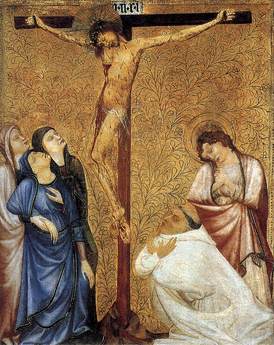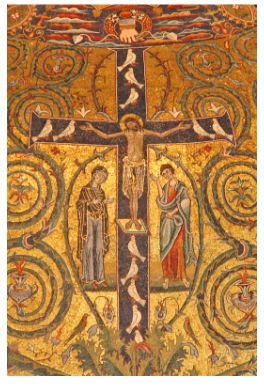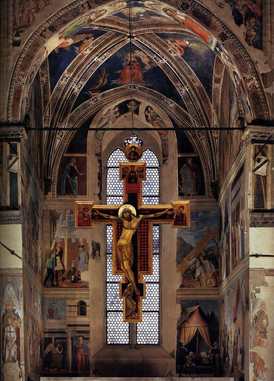 We should glory in the Cross of our Lord Jesus Christ, in whom is our salvation, life and resurrection, through whom we are saved and delivered. (antiphon)
We should glory in the Cross of our Lord Jesus Christ, in whom is our salvation, life and resurrection, through whom we are saved and delivered. (antiphon)
Tag: Exaltation of the Holy Cross
Exaltation of the Holy Cross
Consummatum est. It is completed — it has come to a full end. The mystery of God’s love toward us is accomplished. The price is paid, and we are redeemed. The Eternal Father determined not to pardon us without a price, in order to show us especial favor. He condescended to make us valuable to Him. What we buy we put a value on. He might have saved us without a price –by the mere fiat of His will. But to show His love for us He took a price, which, if there was to be a price set upon us at all, if there was any ransom at all to be taken for the guilt of our sins, could be nothing short of the death of His Son in our nature. O my God and Father, Thou hast valued us so much as to pay the highest of all possible prices for our sinful souls– and shall we not love and choose Thee above all things as the one necessary and one only good?
Blessed John Henry Newman
Meditation on the 12th Station
Exaltation of the Holy Cross
Let us lift up our voices high;
The cross is no failure
 In one respect the cross does have a terrible aspect
In one respect the cross does have a terrible aspect
that we ought not to remove. To see that the purest of men, who was more than a
man, was executed in such a grisly way can make us frightened of ourselves. But
we also need to be frightened of ourselves and out of our self-complacency.
I think, Luther was right when he said that man must first be frightened of
himself so that he can then find the right way. However, the cross doesn’t stop
at being a horror; it is not merely a horror, because the one who looks down at
us from the cross is not a failure, a desperate man, not one of the horrible
victims of humanity.
Spartacus and his failed adherents, because, after all, what looks down at us
from the cross is a goodness that enables a new beginning in the midst of
life’s horror. The goodness of God himself looks on us, God who surrenders
himself into our hands, delivers himself to us, and bears the whole horror of
history with us.
the dangerousness of man and all his heinous deeds, at the same time makes us
look upon God, who is stronger, stronger in his weakness, and upon the fact
that we are loved by God.
brings hope into the abysses of history. God is crucified and says to us that
this God who is apparently so weak is the God who incomprehensibly forgives us
and who in his seeming absence is stronger.
Exaltation of the Holy Cross
God the Father has exalted
Jesus Christ, the Lord of all,
Who has emptied self of glory,
Took our human nature’s thrall;
In obedience, He was humbled
Taking even cross and death;
Now creation shouts in wonder
“Christ is Lord” with ev’ry breath!
As the Cross is boldly
lifted
And the faithful now embrace
What was once a thing so shameful,
Now the hope of all our race,
Let us, marked with Cross, and
baptized,
Shout this news throughout the earth:
Through the Cross, our God has conquered!
Through it, come to His new birth!
87.87. D, no tune
suggested
James Michael Thompson, (c) 2009, World Library Publications
O Cross, our one reliance
The Feast of the Exaltation of the Holy Cross, which, the day after the dedication of the Basilica of the Resurrection raised over the tomb of Christ, is exalted and honored, in the manner of a memorial of His paschal victory and the sign which is to appear in the sky, already announcing in advance His second coming. (Roman Martyrology)
The Church presents to us today a feast which commemorates the discovery of the Holy
 Cross by Emperor Saint Constantine’s mother Saint Helena in Jerusalem (AD 325). The Tradition says that Saint Helena found the Cross and the relics of the holy Passion and then brought them to Rome where they are venerated at the Basilica of the Holy Cross in Jerusalem. On the spot of the discovery, she built the Basilica of the Holy Sepulcher keeping a portion of the Cross at there.
Cross by Emperor Saint Constantine’s mother Saint Helena in Jerusalem (AD 325). The Tradition says that Saint Helena found the Cross and the relics of the holy Passion and then brought them to Rome where they are venerated at the Basilica of the Holy Cross in Jerusalem. On the spot of the discovery, she built the Basilica of the Holy Sepulcher keeping a portion of the Cross at there.
The sacred Liturgy gives us the image of the Holy Cross because it brings together the historical reality of the Cross with its theological import: mystery of the life and death of Christ. This is not a feast celebrating a “terrific find” at an archaeological dig; it is a feast of our faith as the Cross is a central symbol of our faith.
Hymnus in Honore Sanctae Crucis
Vexilla regis prodeunt,
fulget crucis mysterium,
quo carne carnis conditor
suspensus est patibulo.
Confixa clavis viscera
tendens manus, vestigia
redemptionis gratia
hic inmolata est hostia.
Quo vulneratus insuper
mucrone diro lanceae,
ut nos lavaret crimine,
manavit unda et sanguine.
Inpleta sunt quae concinit
David fideli carmine,
dicendo nationibus:
regnavit a ligno deus.
Arbor decora et fulgida,
ornata regis purpura,
electa, digno stipite
tam sancta membra tangere!
Beata cuius brachiis
pretium pependit saeculi!
statera facta est corporis
praedam tulitque Tartari.
Fundis aroma cortice,
vincis sapore nectare,
iucunda fructu fertili
plaudis triumpho nobili.
Salve ara, salve victima
de passionis gloria,
qua vita mortem pertulit
et morte vitam reddidit.
In Festo Exaltationis Sanctae Crucis:
in hac triumphi gloria!
(“Vexilla Regis” was written by Venantius Fortunatus (530-609) and is considered one of the greatest hymns of the sacred Liturgy. This is the full hymn but when used liturgically at Vespers verses 2, 4, 7 are omitted.)


